Wintercreeper Euonymus fortunei 'Harlequin' (v)
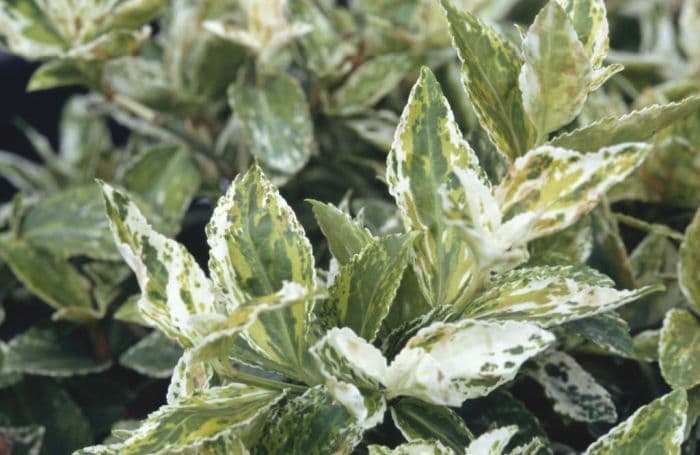
ABOUT
The Wintercreeper 'Harlequin' is well-known for its striking foliage and ground-covering habit. This plant features leaves that are variegated, mixing green with creamy white splotches, giving a marbled or speckled appearance. During the colder months, the white portions of the leaves can develop pink tinges, adding to its visual interest. The leaves are small to medium in size and exhibit a glossy surface, often with a finely serrated edge, creating a textured look. These leaves grow close together, forming a dense mat that spreads over the ground. The overall form of the plant is low and spreading, making it an excellent choice for adding a splash of patterned color to the garden. The Wintercreeper 'Harlequin' can also climb if given support, displaying its attractive foliage at a higher level. It is a versatile and eye-catching variety of the Wintercreeper, fit for various garden uses where visual appeal is desired.
About this plant
 Names
NamesSynonyms
Wintercreeper, Fortune's Spindle, Evergreen Bittersweet, Wintercreeper Euonymus.
Common names
Euonymus fortunei 'Harlequin'.
 Toxicity
ToxicityTo humans
Wintercreeper is known to contain toxic compounds that can be harmful if ingested. Humans who consume parts of the plant, especially the leaves or berries, may experience symptoms such as nausea, vomiting, abdominal pain, diarrhea, and weakness. In some cases, more severe symptoms could occur, depending on the amount ingested. It is important to seek medical attention if ingestion is suspected.
To pets
Wintercreeper is also toxic to pets, including dogs and cats. If pets consume parts of the plant, they may exhibit symptoms like vomiting, diarrhea, abdominal pain, and weakness. In severe cases, ingestion can lead to more serious health issues. Pet owners should contact a veterinarian immediately if they suspect their pet has ingested any part of the plant.
 Characteristics
CharacteristicsLife cycle
Perennials
Foliage type
Evergreen
Color of leaves
Variegated
Height
2 feet (0.61 meters)
Spread
3 feet (0.91 meters)
Plant type
Shrub
Hardiness zones
5
Native area
Asia
Benefits
 General Benefits
General Benefits- Low Maintenance: Euonymus fortunei 'Harlequin' is known for being easy to care for, requiring minimal pruning and upkeep once established.
- Versatile: This plant can be used in a variety of garden settings, including borders, foundation plantings, and as ground cover.
- Year-Round Interest: 'Harlequin' has attractive variegated foliage that provides visual appeal throughout all seasons.
- Drought Tolerance: Once established, it is quite tolerant of dry conditions, making it suitable for gardens with less water availability.
- Pest Resistance: This cultivar tends to be more resistant to pests compared to other plants, reducing the need for chemical interventions.
- Adaptability: It can adapt to a range of soil types and pH levels, making it suitable for many different garden environments.
- Frost Hardy: It is able to withstand cold temperatures and can survive in regions with frosty winters.
- Fast Growth: 'Harlequin' has a relatively quick growth rate, enabling it to fill in garden spaces efficiently.
 Medical Properties
Medical PropertiesThis plant is not used for medical purposes.
 Air-purifying Qualities
Air-purifying QualitiesThis plant is not specifically known for air purifying qualities.
 Other Uses
Other Uses- Winter Creeper can be used as a natural fabric dye, providing various shades of green and yellow depending on the mordant used.
- Because of its dense foliage, Winter Creeper can be trained over frames to create living sculptures or topiaries in gardens.
- Its climbing habit allows it to be used as a screen for fences or walls, offering privacy and aesthetic improvement to urban spaces.
- The plant can be used in terrariums or fairy gardens for a splash of color and texture among miniature landscapes and figurines.
- Winter Creeper can be grown in hanging baskets to create cascading foliage that adds vertical interest to indoor or outdoor spaces.
- Its resilience and spreading habit make it suitable as a living mulch to suppress weeds and retain soil moisture in garden beds.
- Winter Creeper branches can be harvested and woven into natural wreaths and other forms of botanical decor.
- The plant can be used in educational settings, such as schools or botanical centers, to teach pruning techniques and plant propagation methods.
- Winter Creeper can be used in noise reduction strategies in landscapes, as its dense growth can help absorb sound waves.
- Gardeners can use the plant as a companion to shade-loving perennials, providing ground cover and contrasting foliage to enhance garden design.
Interesting Facts
 Feng Shui
Feng ShuiThe Wintercreeper is not used in Feng Shui practice.
 Zodiac Sign Compitability
Zodiac Sign CompitabilityThe Wintercreeper is not used in astrology practice.
 Plant Symbolism
Plant Symbolism- Resilience - Euonymus fortunei 'Harlequin', commonly known as Wintercreeper, often symbolizes resilience due to its ability to thrive in a range of conditions and its vigorous growth habit.
- Versatility - The Wintercreeper's variegated leaves and adaptability to different environments represents the idea of versatility and flexibility in life.
- Survival - As a hardy plant that can withstand challenging circumstances, Wintercreeper often stands for the strength to survive and prosper in the face of adversity.
- Endurance - Its evergreen nature and ability to stay vibrant through all seasons make Wintercreeper a symbol of endurance and lasting presence.
 Water
WaterWintercreeper should be watered thoroughly, ensuring that the root ball is moistened and that excess water has a chance to drain away. The plant prefers consistently moist soil, but it's important to allow the top inch of soil to dry out between waterings to prevent root rot. Watering frequency depends on the climate and weather conditions, but on average, watering once a week should suffice. During extremely hot or dry periods, you may need to increase watering to twice a week. Typically, giving Wintercreeper about one gallon of water per plant each time you water will maintain proper hydration.
 Light
LightWintercreeper thrives in a variety of lighting conditions, from full sun to partial shade. The ideal spot for this plant would receive morning sunlight and partial shade in the afternoon to protect it from the intense heat of the day. However, it is versatile and can also grow in more shaded areas, where the variegation of the 'Harlequin' leaves can provide bright spots in the garden.
 Temperature
TemperatureThe ideal temperature range for Wintercreeper is between 60°F and 80°F. It is hardy and can tolerate minimum temperatures down to around -20°F and maximum temperatures up to about 90°F for short periods. Nonetheless, consistent temperatures within the ideal range promote the best growth and foliage appearance for Wintercreeper.
 Pruning
PruningPruning Wintercreeper helps maintain its shape, control its size, and encourage new growth. The best time to prune is in late winter or early spring before new growth begins. It can be pruned as often as needed to maintain the desired form, but typically once or twice a year is sufficient. Always use clean, sharp tools to make precise cuts and minimize any stress on the plant.
 Cleaning
CleaningAs needed
 Soil
SoilWintercreeper prefers well-draining soil with a mix of potting soil, peat moss, and perlite; it thrives in a pH range of 6.0 to 8.0.
 Repotting
RepottingWintercreeper should be repotted every 2 to 3 years to refresh the soil and accommodate root growth.
 Humidity & Misting
Humidity & MistingWintercreeper tolerates a wide range of humidity levels but prefers moderate humidity; no need for specialized humidity control.
 Suitable locations
Suitable locationsIndoor
Place in bright, indirect light and avoid overwatering.
Outdoor
Plant in partial shade to full sun; mulch to retain moisture.
Hardiness zone
5-9 USDA
 Life cycle
Life cycleEuonymus fortunei 'Harlequin', also known as Wintercreeper 'Harlequin', begins its life as seeds which germinate in suitable conditions of warmth and moisture. The seedlings emerge, develop roots, and sprout their first leaves, entering the growth stage where they establish themselves and grow vigorously, often spreading through stem cuttings or rooting along the stems. As they mature, these evergreen perennials form a dense, woody growth habit, with variegated leaves that can exhibit white and green patterns. Wintercreeper 'Harlequin' does not flower prominently and often goes unnoticed in this stage, focusing energy on vegetative expansion over sexual reproduction. In the absence of significant flowering and seed production, the plant often propagates vegetatively as its stems touch the ground and root, expanding the plant's coverage area. The life cycle revolves around growth, vegetative propagation, and eventually senescence as individual stems or the whole plant age and decline in vigor, although they can live for many years with proper care.
 Propogation
PropogationPropogation time
Spring-Early Summer
The Wintercreeper 'Harlequin' is commonly propagated through semi-hardwood cuttings which is the most popular method due to its ease and effectiveness. To successfully propagate, the best time is typically during summer when the plant has finished its main flush of growth and the stems are partially mature yet still flexible. A 4 to 6 inch cutting is taken from a healthy parent plant, with the lower leaves removed to expose the nodes where roots will form. The cut end is then dipped in rooting hormone to encourage root growth and planted in a well-draining soil mixture. To maintain high humidity, which is crucial for root formation, the cutting can be covered with a plastic bag or placed in a misting chamber. After several weeks to a few months, the cutting should develop roots and can be transplanted to a larger pot or directly to an appropriate garden location.
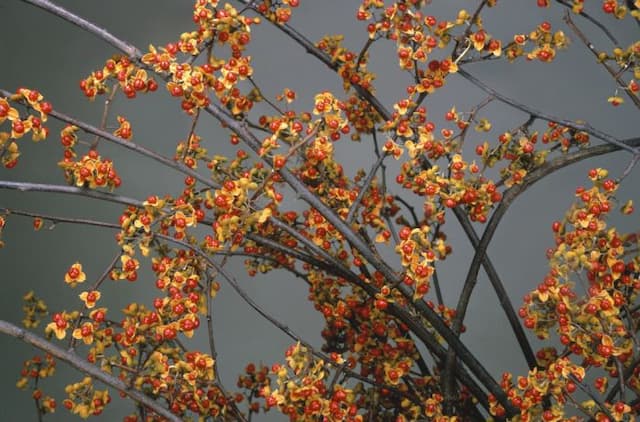
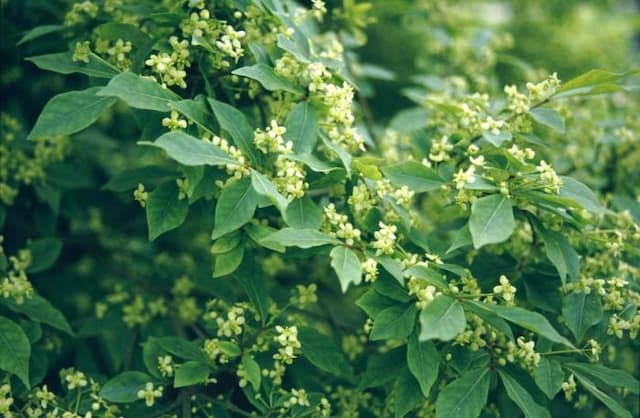
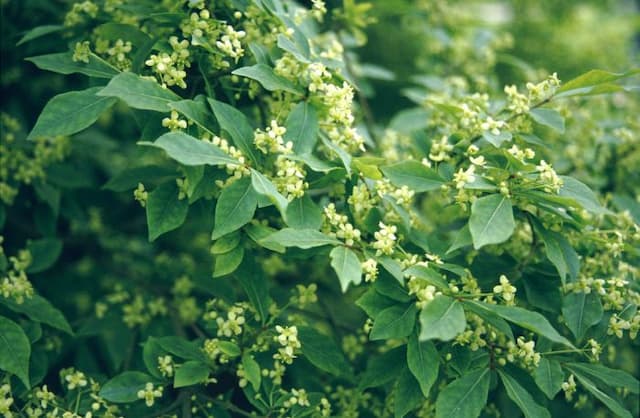

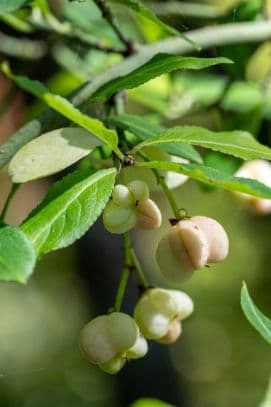
![Spindle [Blondy]](/_next/image?url=https%3A%2F%2Fplants-admin.emdemapps.com%2Fimages%2Fplants%2F%2Fimages%2F604b642f54add.png&w=640&q=75)


